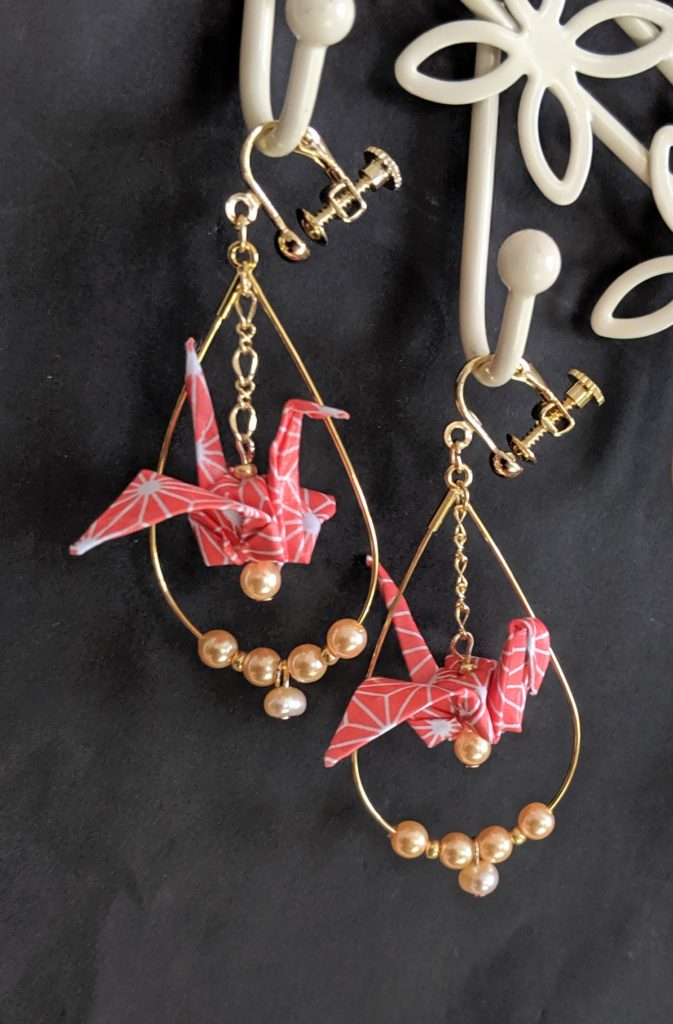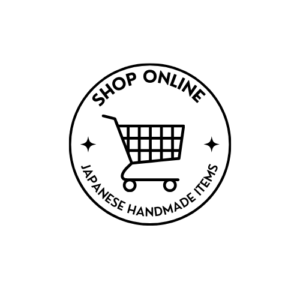Category: English
Interview with [satokomatsu] by Resobox
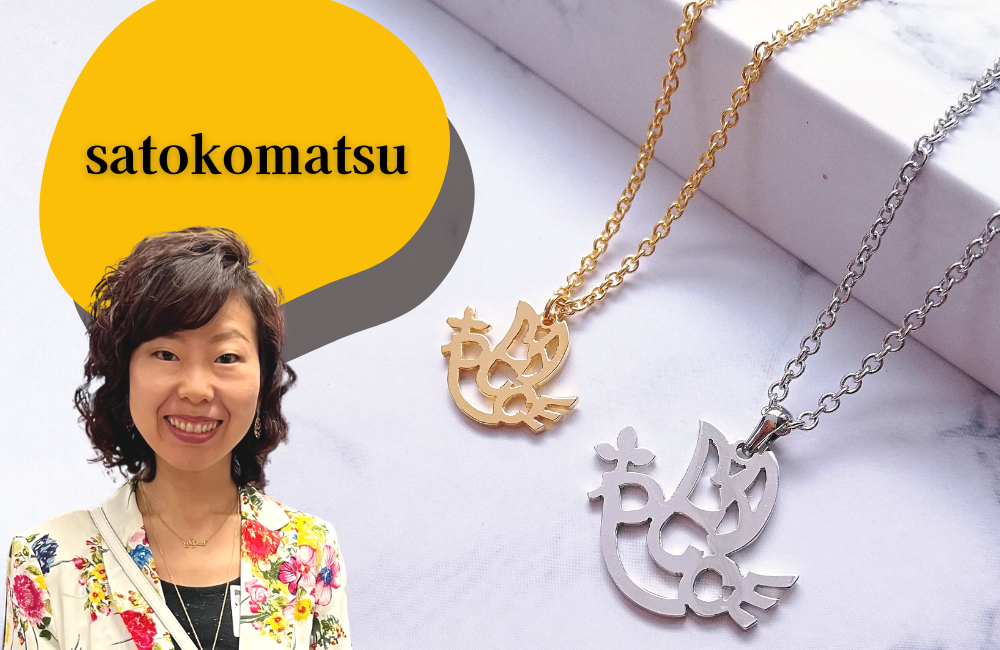
This post was orinigally published on Resobox website. (https://resobox.com/news/satokomatsu/)
We often receive messages on our website with questions and comments like “What kind of artists are active?” “What is the secret of the event’s popularity?” “I want to participate next time!” If you’ve been wondering some of these things yourself, this interview series is here to shine some light on what happens behind the scenes while preparing for a Pop-Up Shop.
This time, we interviewed Satoko Komatsu, an artist who creates “text image jewelry” based on Arabic and Japanese characters, among others, under the brand “satokomatsu“. We asked for Ms. Komatsu’s thoughts about the appeal of her work, which seeks to connect people through her accessories.
Q: The unique and simple jewelry inspired by words is quite attractive. Can you tell us about your process and your goals when making jewelry?
I sketch the design by hand and then cut the design out of a brass or silver plate using a jeweler’s saw. I then add a gold plating to finish the accessory. The main motif of my work is “words”. I hope that by wearing my jewelry, it becomes a communication tool that connects people, prompting conversations like “That’s a lovely necklace, what inspired it?” and “Actually, the meaning of this piece I’m wearing is…”.For me, making jewelry is a challenge to create a bridge that connects people, much like words do. It would make me happy if I could connect with many people through my work.
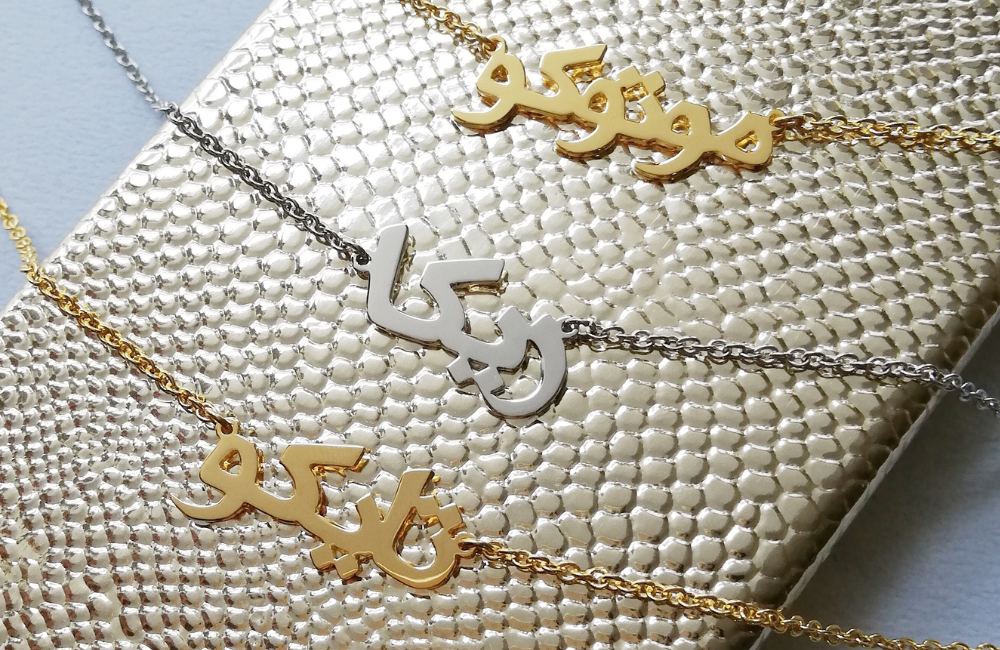
Q: It’s interesting how you use animals, plants, and not just hiragana and Roman script, but also Arabic characters in your designs. What inspired you to use language as a motif?
The act of combining characters to create a shape has been a popular pastime in Japan since the Edo period. Many people may have seen illustrations created by combining hiragana characters, such as “ひつじ”. I first encountered Arabic during my university days while I was studying abroad. I was drawn to the elegance of its curved lines and found the decorative look of the characters to be charming. Although not widely used in Japan, Arabic is famous as the language of the Islamic holy book, the Quran. It is one of the six official languages of the United Nations and the third most spoken language in the world.
Because my father was an English teacher and my mother taught calligraphy, I grew up surrounded by letters, and have always been interested in foreign languages and cultures. These experiences growing up led me to have a passion for learning languages; so far I have studied English, Italian, Arabic, Hebrew, Tibetan, and German. Everything I’ve learned over the course of my studies has led me to my current method of designing new pieces.
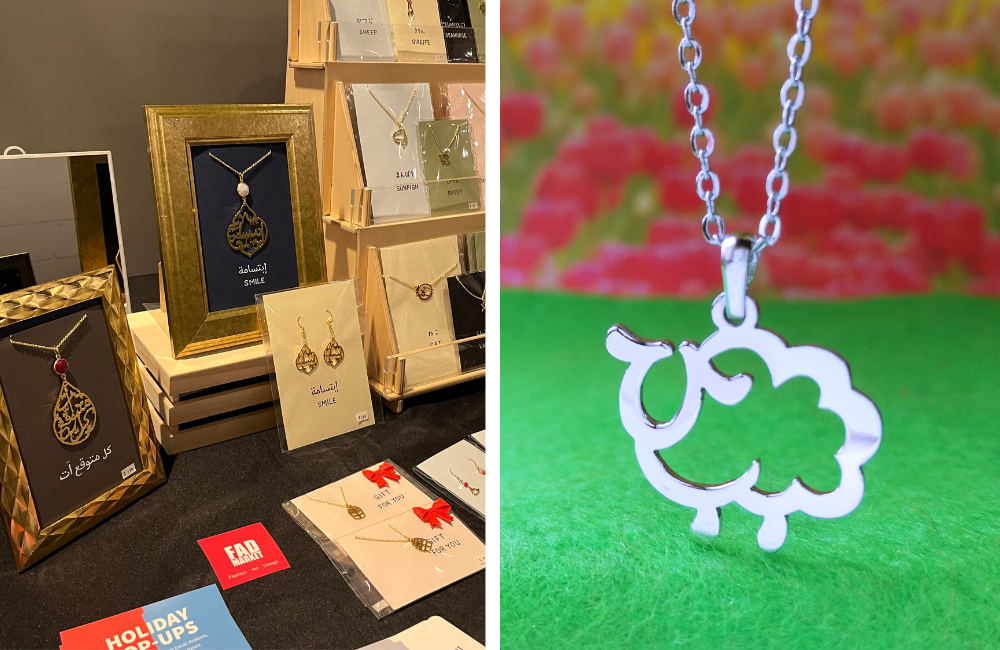
Q: NYK Marketing is hosting a pop-up shop in New York and selling products on various online marketplaces in Japan and the United States, such as “etsy,” “creema,” and “minne.” Are there any particularly popular items?
In the Etsy shop, which receives many orders from the United States and Europe, customers are especially drawn to accessories featuring designs like camels and cherry blossoms. Some customers have commissioned jewelry that expresses their gratitude or appreciation for the recipient. Using words like “Thank you” as the basis of this design, an unexpected gift is created that serves as a lasting reminder of these feelings. There has also been an uptick in commissions for designs featuring names of celebrities, which people can wear to show their interest and support.
Arabic name necklaces are popular among Japanese customers. Because they cannot be recognized as names at a glance like English can be, at least in Japan, they make unique gifts, and can be worn almost like an omamori, or protective charm. We have received over 100 orders so far, all of which are custom-made. We carefully design each item with consideration for the balance of the letter placement and size.

Q: Could you tell me about how you became a jewelry designer and started your career in New York?
It’s a long story, but when I was a freshman in college, I visited Italy and was drawn to the universal beauty of jewelry that everyone could appreciate. Later, while still attending university, I began studying design at a vocational school, and during my junior year, I took a leave of absence to study design and production at a jewelry school in Italy. After graduating from university, I became a jewelry designer for a Japanese company. My work was rewarding; my creations were displayed in department stores and I had the opportunity to participate in international jewelry fairs. However, after getting divorced, I felt that “now it’s time for me to be free” and resigned from the company where I had worked for over seven years. I moved to New York, where top aspiring designers from around the world gather, to expand my knowledge of jewelry design while also utilizing my previous experience. Due to visa issues, I returned to Japan after a year, but I met my current husband during my time in New York and was able to obtain a fiancé visa to immigrate. And that brings me to where I am now.
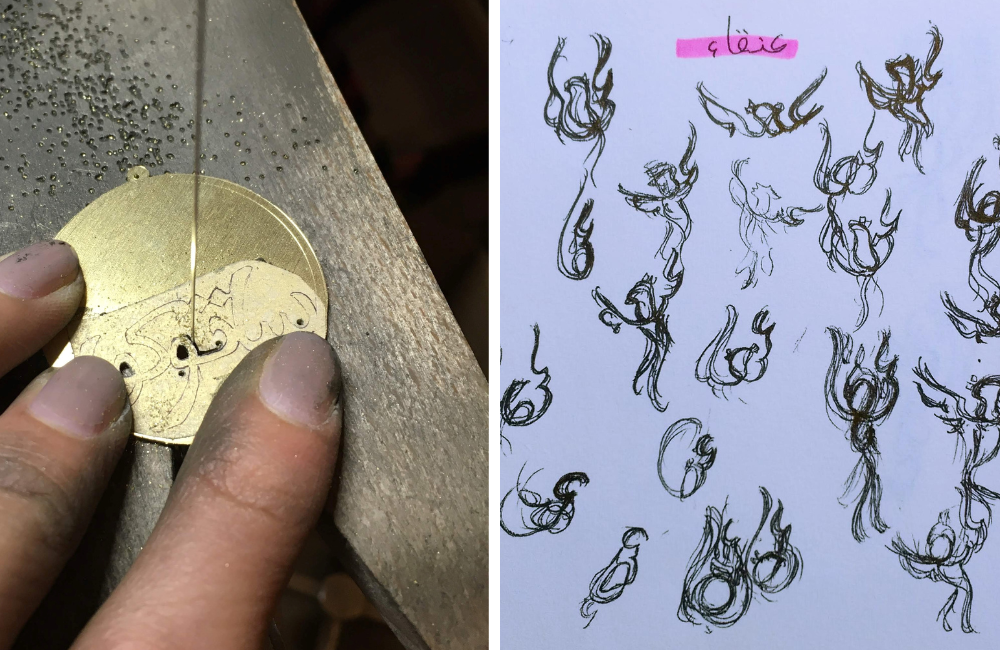
Q: Have you noticed any differences in design preferences between different countries, given that you’ve studied jewelry in various places such as Italy, the US, and Japan?
In Japan, due to my experience working for a larger company, accuracy and designs that are favored by a broad range of consumers were highly valued. Additionally, there is a tendency in Japan to feel more at ease when people’s accessories are matching, or look similar to what’s already popular, and I feel that this is reflected in the designs that are available there. On the other hand, in Europe, designs that are inspired by nature and are more image-oriented are prominent. In the United States, it is difficult to single out any one prevalent theme due to the diverse mix of people from different races and cultures. Just as people have their own identity, in which race and culture play roles without making up the whole of someone’s image, there is a vast array of different designs that we can enjoy and be inspired by.
Q: How did you encounter the “Japanese Artist Pop-up Shop”? What are the advantages of a physical shop over an online marketplace?
When I moved to New York, I was looking for a place to exhibit my artwork, and I discovered the “Japanese Artist Pop-up Shop” while searching for exhibition venues. I visited the shop as a customer and had a chat with the person in charge. We hit it off, and I was able to exhibit my work there.
The advantage of a physical shop is that it allows you to talk to a variety of people and make new acquaintances through your artwork. One of my representative works is an accessory that depicts the shape of a dog using the Japanese hiragana characters “i” and “nu.” When I tell customers, “Actually, it says ‘inu,’ which means dog in Japanese,” it leads to conversation and information exchange, sometimes even to personal talk. At that moment, jewelry becomes a communication tool beyond nationality and race, and I feel the satisfaction and happiness of my work. Also, I often get inspiration for new pieces from real-time reactions and feedback from customers.
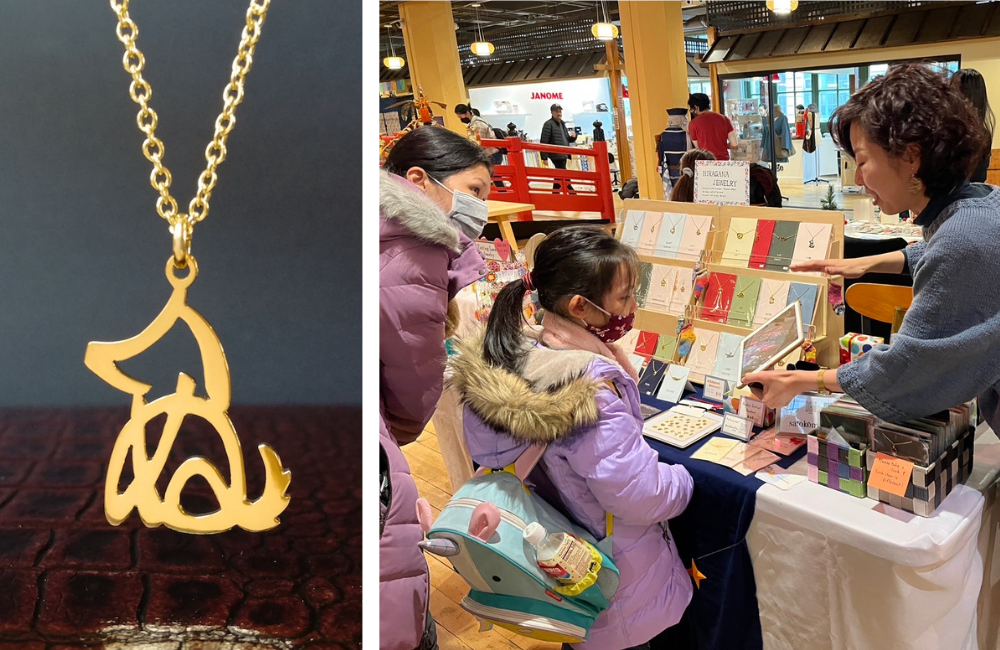
Q: Could you tell us a little about your goals for the future?
I will continue to create jewelry with the motif of “language” that celebrates the links between people. Instead of turning to mass production, I will keep making each piece by hand, and I would be happy if my work could become a bridge that connects people and countries all over the world. In New York, I have also received requests for hiragana designs and small motifs, so while cherishing my own style, I want to grow by taking on new challenges.

This post was orinigally published on Resobox website. (https://resobox.com/news/satokomatsu/)
About Resobox
The place where people who are conversant with, dedicated to, and influenced by Japanese culture can gather, create innovative arts through the collaborative process and disseminate them to the world.
What’s in the Box?
RESOBOX is the name created from a mashup of the words Resonate and Box.
This Resonating Box envisions a space where people can meet and collaborate to create new and innovative Japanese culture. The space within this Box Resonates, too, shaking up everything inside.
Japanese people are welcome, and so are the many non-Japanese people who understand and find themselves being influenced by the arts of Japan.
These artists can meet in RESOBOX, and create new works by adding and mixing in their sensibilities, playing a great role in preserving, and even developing Japanese culture.
In today’s global environment, Japanese culture might not always emanate from Japan alone, but also from places like New York City, where culture is highly concentrated and widely disseminated to the world at large.
The founders of RESOBOX believe that by promoting such artists, truly innovative and more sophisticated Japanese culture can evolve, resonating with people all over the world.
Interview with [pucci ropa jewelry] by Resobox
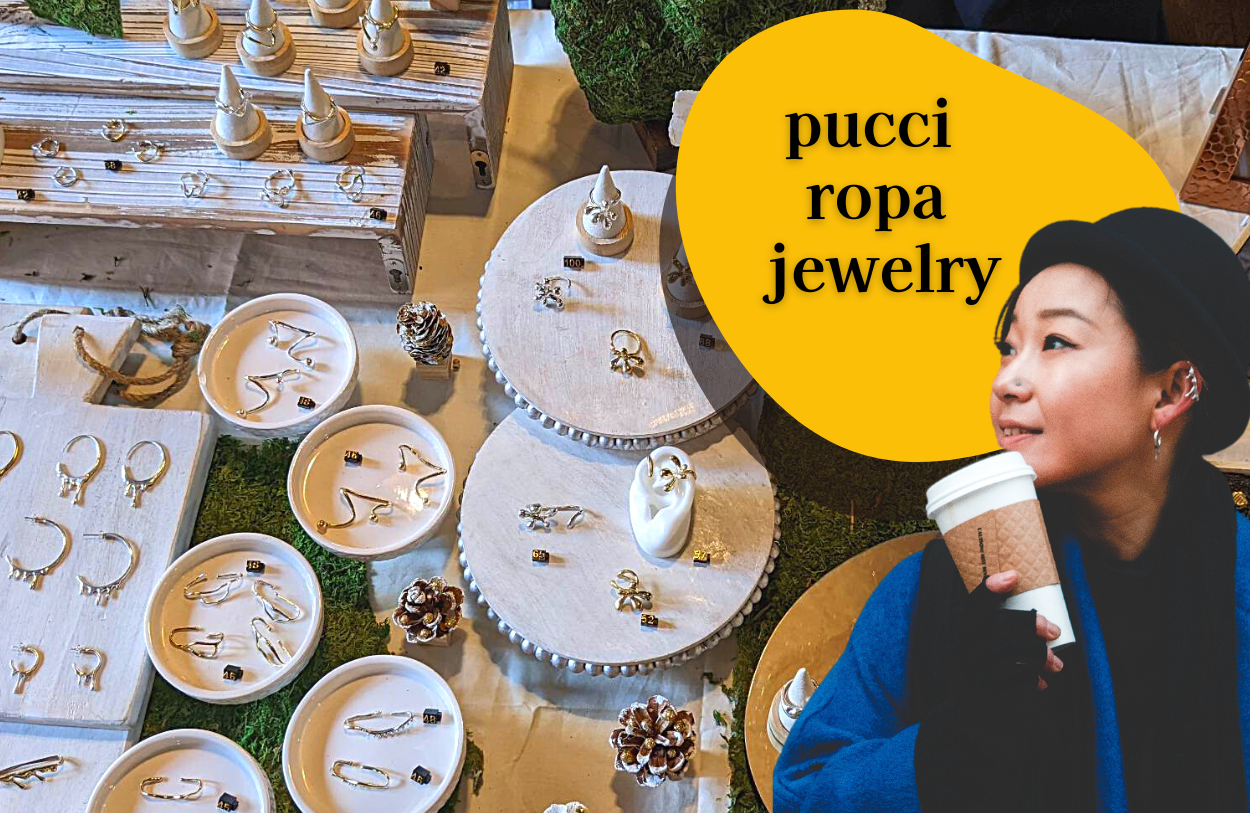
This post was orinigally published on Resobox website. (https://resobox.com/news/%E3%80%90nejapanese-artist-pop-up-shop11/)
On February 26, 2023, “Japanese Artist Pop-up Shop 11” was held at RESOBOX East Village, featuring a variety of booths selling accessories and other goods by Japanese artists in New York and local artists whose works are related to Japan. This collaboration was planned by NYK Marketing, an event company in NY, as a means to connect artists and consumers, as well as a forum for artists to interact with each other. The Japanese Artist Pop-Up Shop has been held at our RESOBOX space since 2018, and this was its eleventh iteration.
With more than 400 people coming to the six-hour-long event, its popularity has ballooned since it was first held, and many attendees from past markets make a point of coming to new ones. Yoko Ito, the president of NYK Marketing, was featured in the newsletter of Felissimo, a major Japanese lifestyle goods company, for her work in spearheading this successful assembly of artists.
“What kind of artists are invited to the pop-up shop? What is the secret of their popularity?” In response to these types of questions, we interviewed Chihiro Takeshita, an accessory artist who has been appearing at the Japanese Artist Pop-Up Shop since 2019. Ms. Takeshita launched her brand “pucci ropa jewelry” with the motto “jewelry that makes everyday fun,” and creates rings, earrings, and other items.
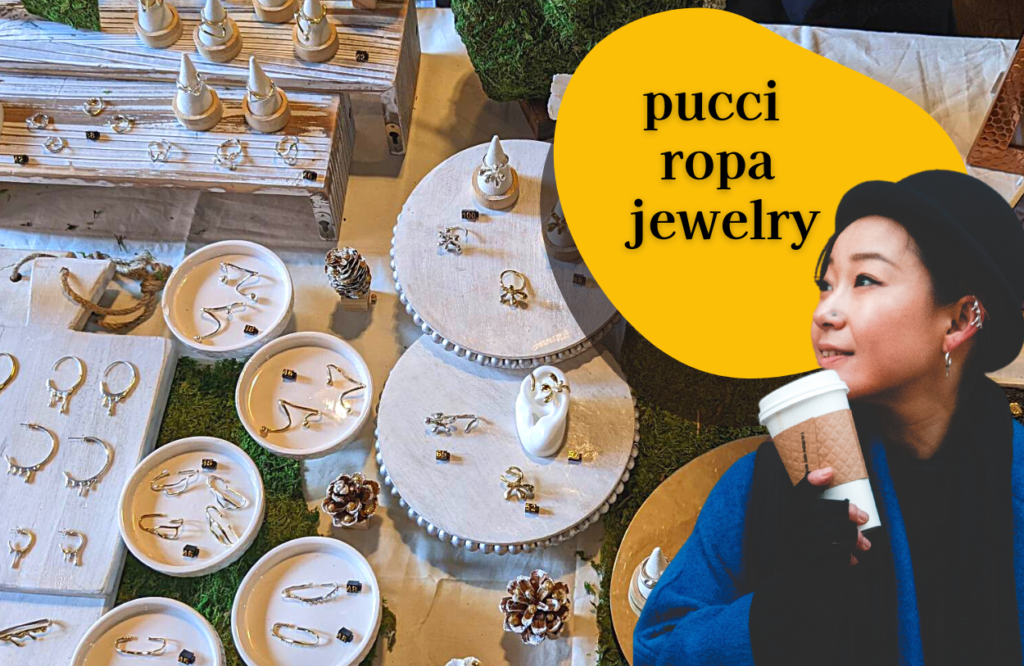
Q/ Your individuality shines through in your intricate silver accessories. First of all, please tell us about the characteristics of your work and your thoughts behind the brand name “pucci ropa jewelry.
I mainly create accessories using sterling silver and brass.
My own preference is for “designs with a unique personality” rather than “stripped-down” beauty. The designs favored by New Yorkers are also accessories with a strong presence, so I mainly focus on making that type of jewelry.
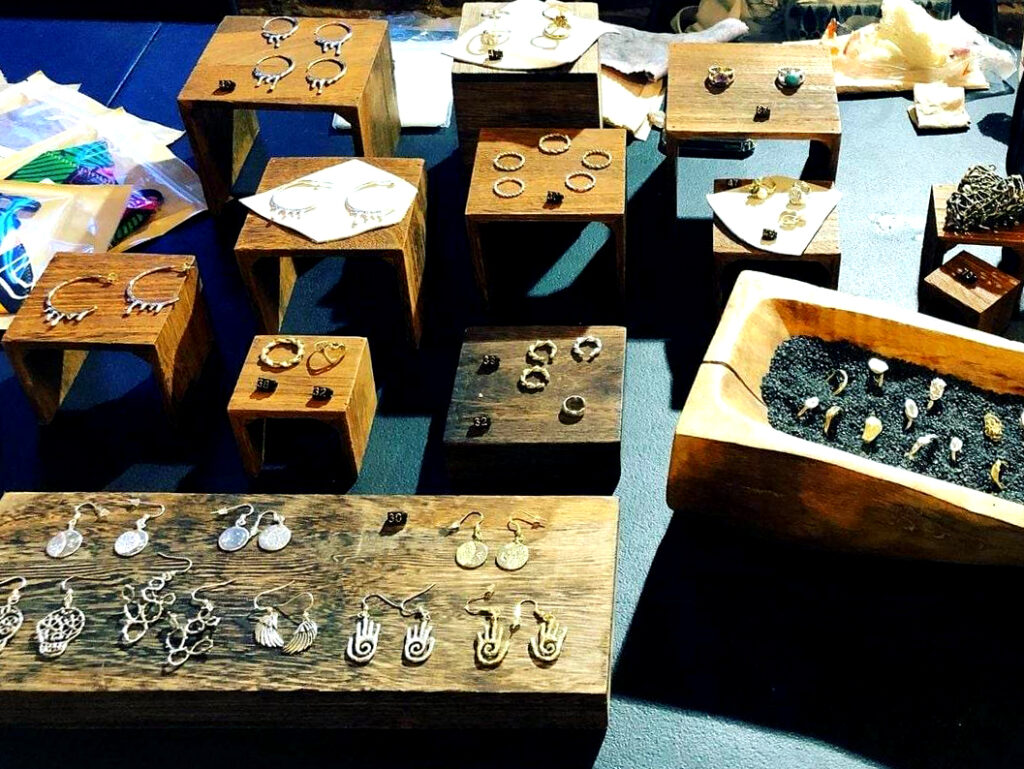
The brand name “pucci ropa jewelry” is a combination of the word “Pucci,” which means ‘small’ and is my nickname because I am petite, and “Ropa,” which means ‘clothing’ in Spanish. I decided to use this word for the name of my brand. Since coming to New York, I have often been deeply moved by the welcoming energy of my Mexican neighbors, so I decided to use this word in the brand name.
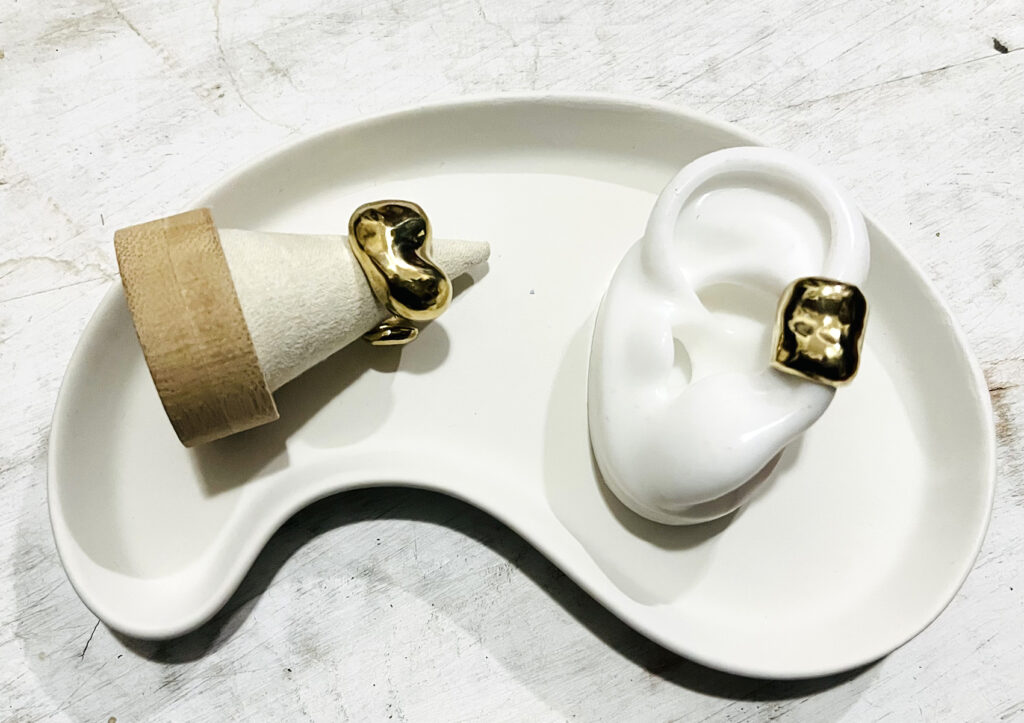
Q/How did you come to work as an accessory artist in New York?
I first started living in New York City in 2010. Before that, I was working as a hip-hop dancer in Tokyo, mainly at events, clubs, and fitness studios, but I had a strong yearning to study dance seriously in New York, the sacred land of dance, so I took the plunge and came to the U.S. After arriving in NYC, I joined a dance company while learning English, and was also blessed with the opportunity to teach dance to local children. During those days, I became increasingly attracted to the energetic mood of the city where people who are serious about taking on challenges gather.
Later, I had to return to Japan for unavoidable reasons. However, while I was in New York to pick up my belongings, a friend suggested, “Why don’t you study abroad at an art school?” I came back to NYC in 2015, and wound up enrolling in a school where I learned to make jewelry. In 2017, I started making metal jewelry, which I had been interested in but hesitated to do because of the high cost to get started. Yet I put all my effort into it, and when I began exhibiting my work, acquaintances began asking me to make custom pieces for them, and I found myself receiving orders as an artist.
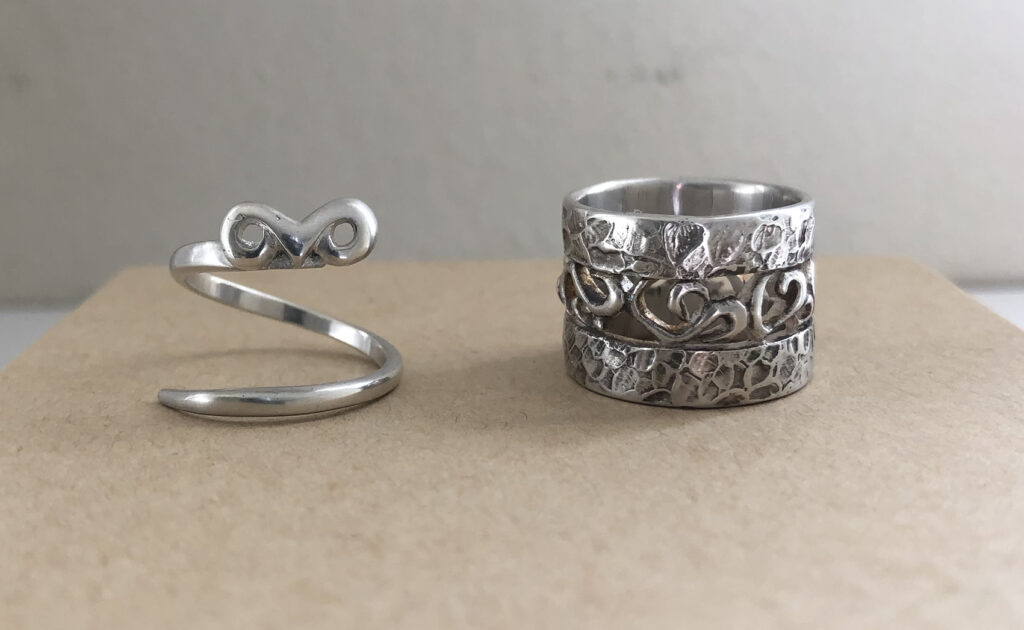
Q/ How did you find “Japanese Artist Pop-up Shop”? What was good about joining the event, and what do you find appealing from an artist’s point of view?
I decided to participate through an introduction from a friend who had been participating since the first show. I thought about setting up a personal online store to sell my works, but many of my works have curves and forms that feel good on the skin, so it is easier for people to find them attractive if they actually wear them. Being able to participate in pop-up shops has increased the number of instances in which customers try on and then purchase my products.
There is also the advantage of being able to listen to customers’ opinions directly. We can learn about the designs that New Yorkers like and enjoy chatting with them while adjusting their sizes on the spot.
I was also happy to meet people who dropped by on a whim, and to make connections with other artists who participated in the event. The more I participate, the more my sales improve, and I am grateful for the opportunity it has given me to become more serious about my business.
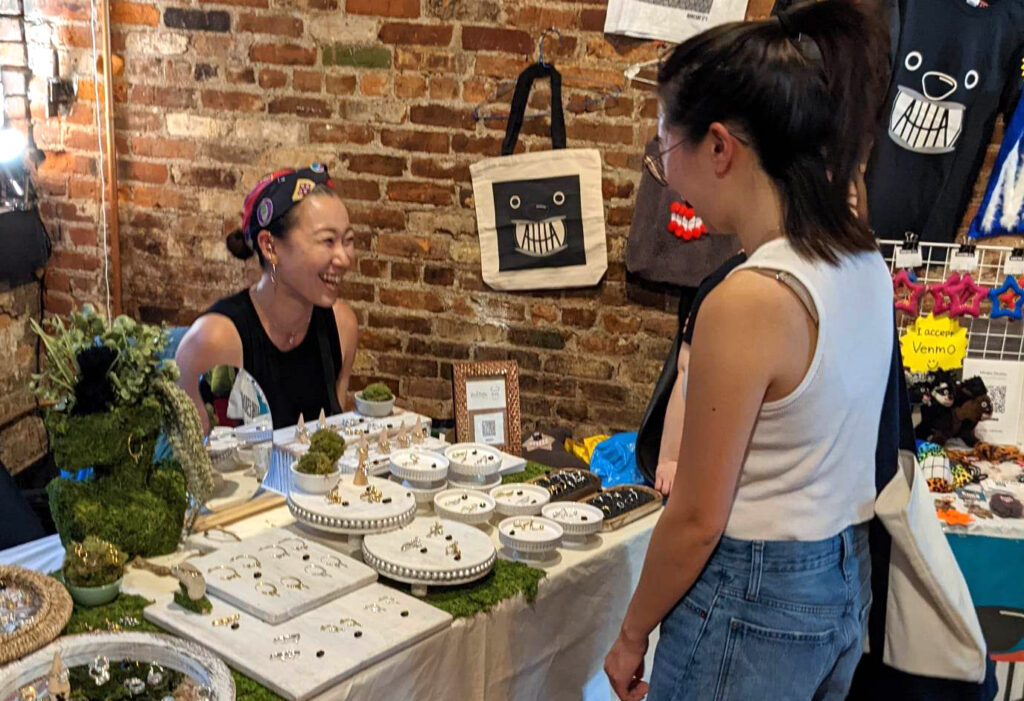
Q/Your work is posted on Instagram. Many of the designs are unique and one-of-a-kind, and it is exciting to see them. Can you tell us what you want to express in your works and what you feel your signature creations are?
I create my pieces by focusing on events that have touched my heart and moments that have shaken my emotions. Therefore, all of my creations have a meaning and a title.
One of my signature works is a ring named “Amoeba”; I wanted to express a 3D, uneven design, and when I was doing some research, I was fascinated by amoebae. Digging deeper, I found that an amoeba has the characteristic of constant change, and that it also means evolution, revolution, and transformation. I was so excited that I decided to make it into a work of art. The complicated shape makes it difficult to work with, but I carefully finish each piece in the hope that it will become an item that encourages change and evolution in the people who wear it.
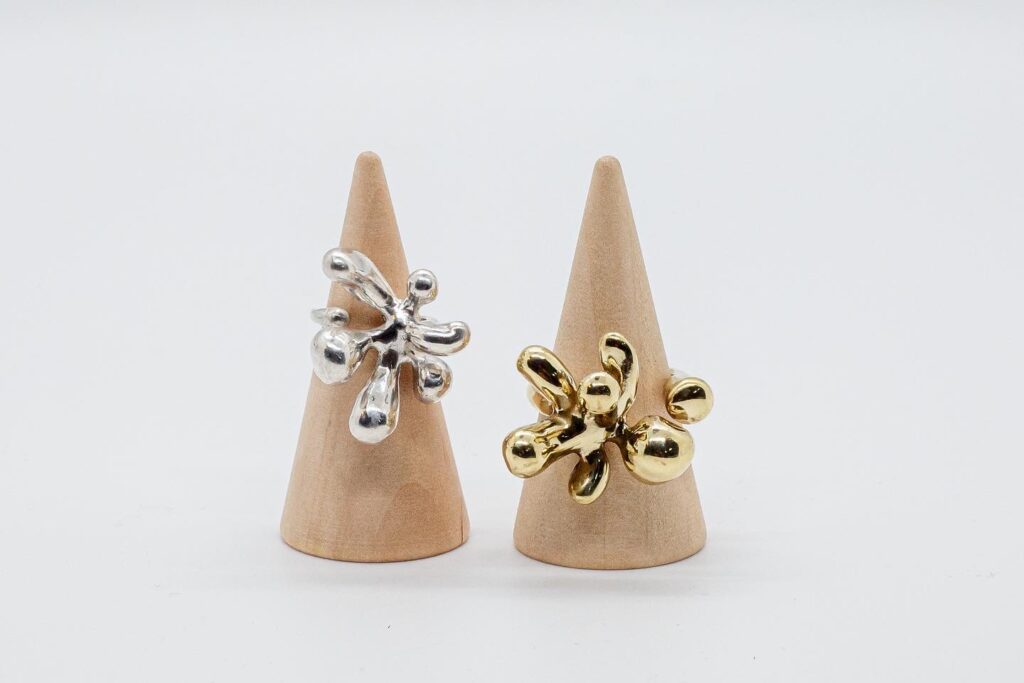
The ring based on the theme of the song “WINDING ROAD,” a collaboration between Japanese singers, Ayaka and Kobukuro, is another item that I have a strong attachment to. The design was inspired by the lyrics of the song, “Many little lights waiting at the end of a winding road,” which encouraged me personally. I hope that my work, which was born from my own experience, will inspire customers to feel supported on their journey, a sort of good luck charm. I would feel happy if my pieces become items to help people enjoy everyday life.
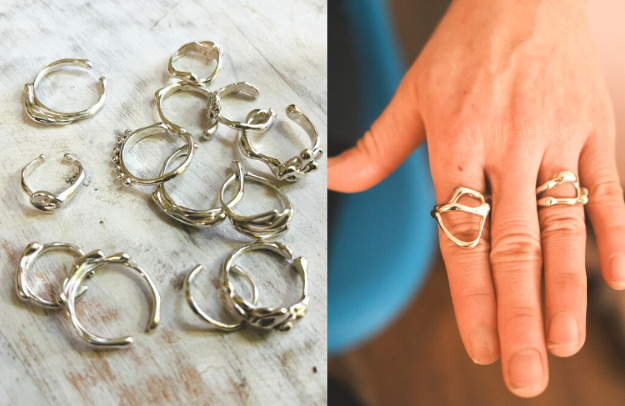
Q/ What is your outlook for the future?
New York has an environment in which it is acceptable to take on challenges at any age. I feel that I am able to walk into a future that I would not have been able to choose if I had stayed in Japan because I was concerned about the eyes of those around me.
As for recent news, a vintage clothing store in NYC likes my work so much that they have decided to keep it in their store. At one event, a fashion-forward gentleman asked if I could make one of my designs in gold, for men. Little by little, I feel that my efforts are bearing fruit; I am gaining recognition, and an environment is being created for me to expand my activities.
In 2023, I plan to focus more on jewelry making and gradually expand my brand. I am also considering creating a mail order site, so I would be happy if people living outside of New York could come in contact with my work.
The place where people who are conversant with, dedicated to, and influenced by Japanese culture can gather, create innovative arts through the collaborative process and disseminate them to the world.
What’s in the Box?
RESOBOX is the name created from a mashup of the words Resonate and Box.
This Resonating Box envisions a space where people can meet and collaborate to create new and innovative Japanese culture. The space within this Box Resonates, too, shaking up everything inside.
Japanese people are welcome, and so are the many non-Japanese people who understand and find themselves being influenced by the arts of Japan.
These artists can meet in RESOBOX, and create new works by adding and mixing in their sensibilities, playing a great role in preserving, and even developing Japanese culture.
In today’s global environment, Japanese culture might not always emanate from Japan alone, but also from places like New York City, where culture is highly concentrated and widely disseminated to the world at large.
The founders of RESOBOX believe that by promoting such artists, truly innovative and more sophisticated Japanese culture can evolve, resonating with people all over the world.
Japanese Craft Fair /Resobox/Feb 26th(Sun)
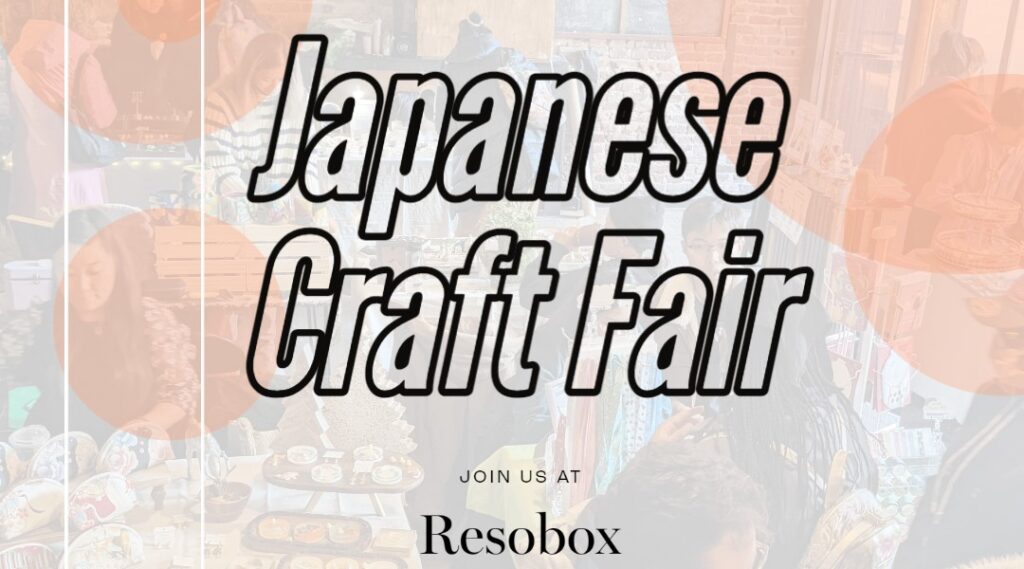
Accessories such as earrings, necklaces, and more Japanese-inspired products will be on sale! Japanese artist and Japanese-inspired artists are all welcome to join and promote their works! Please join us and see each artist’s unique creations! We will have Japanese food and snacks at the event!
■Location:91 E 3rd St, New York, NY 10003
■Date: Feb 26th(Sun) 12PM~6PM
■Event Brite:https://www.eventbrite.com/e/japanese-craft-fair-resobox-tickets-520855742547
Our Vendors
【MEINFINITY】
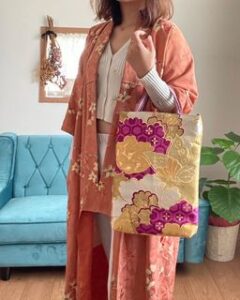
Our handmade bags are made by upcycling vintage kimonos and obis. Kimono obis are made of silk. The fabrics have unique designs of such quality that you feel as if you are wearing Japanese artwork. These bags are for anyone who would like to have unique designs based on Japanese culture. By owning your own Japanese bag, you can always have a piece of Japanese culture with you.
【STUDIO HARU】
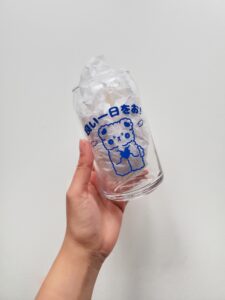
Studio Haru is a minimal stationery & gift shop based in New York City, opened in 2020 by 元恩典 Grace E.G. Creating art, minimalism, and slow living.
The shop’s name means Spring 春 (Haru in Japanese) (“my favorite season”).
The shop focuses on creating minimal-kitsch stationery, apparel, accessories, tableware, and décor, where every collection is brought to life “by things that inspire me”.
【Poiful rug】
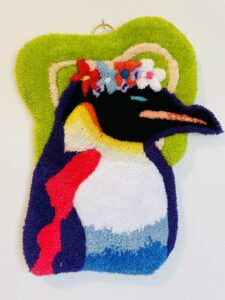
HOKKORI KAWAII hand made rugs. We create beautiful, hand crafted rugs with various designs inspired directly from Japanese culture and nature. They have a variety of uses such as brightening a room, bringing joy and delight, and of course, making an excellent gift for family and friends.
【Hooks and Luxe】
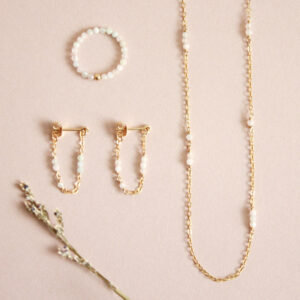
Hooks and Luxe is an NYC based accessories brand that the designer, Ryoko, creates by hand with meticulous care. After studying at Parsons the New School For Design, she was looking for something that would tap into her creativity and design skills and found that accessories design was right up her alley. She is originally from Japan and believes that it influences the softness and delicacy in her design, showing up in her jewelry, which could be the perfect accessories for adding a little dainty sparkle to your outfit.
【bearysukie】
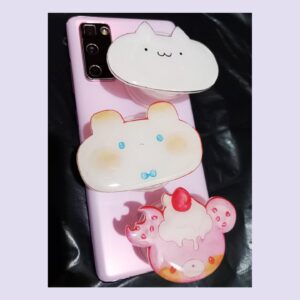
Anime/kawaii/children illustration merchandise- zine, stickers, print, original art, tote bag, keychain, phone charm, buttons, phone grip.
【Fragrant Olive】
【Lunaris】
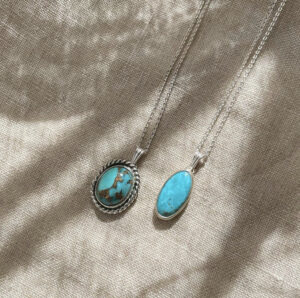
Lunaris. Luna (Moon)× Iris (Rainbow) If only you could see the moon and a rainbow together. Imagine the excitement you would have. My hope is that my handmade jewelry can give you that same feeling.
【Unipaca Studio】
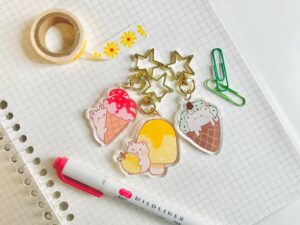
Cute handmade stationery items like vinyl stickers, sticker sheets, and acrylic keychains! I also enjoy drawing anime-inspired art prints and have many future projects to come!
【Japanklyn】

Japanklyn was founded in 2020 in Brooklyn, NY.
It all started in a small apartment with our love and compassion for Japan and Brooklyn and a passion for fashion, specifically hat.
The pride, respect, and patriotism for Japan and the culture, along with love for our community, culture, and lifestyle of Brooklyn, all fused like a chemical reaction.
Japanese Food will be sold at the event !!
Japanese Curry And Rice by “Kare Girls 華麗な女子達”
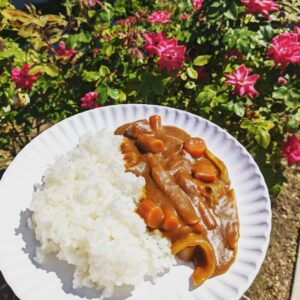

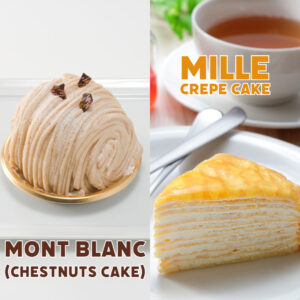
Oyamada Japan
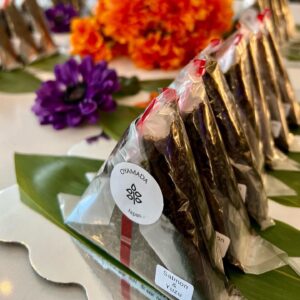
Founder Sayuri Oyamada has traveled throughout the world as a successful actress. Her passion is to send out positive and unique Japanese traditions and culture to the world. ONIGIRI is Sayuri’s personal project that is taking the traditional Japanese rice ball, Onigiri, and bringing it to the world with a unique blend of flavors that will expand your palate. Currently, She also has started Sushi Rolls delivery service that especially vegan options available.
Holiday Japanese Handcraft Show/East Village/December 4th
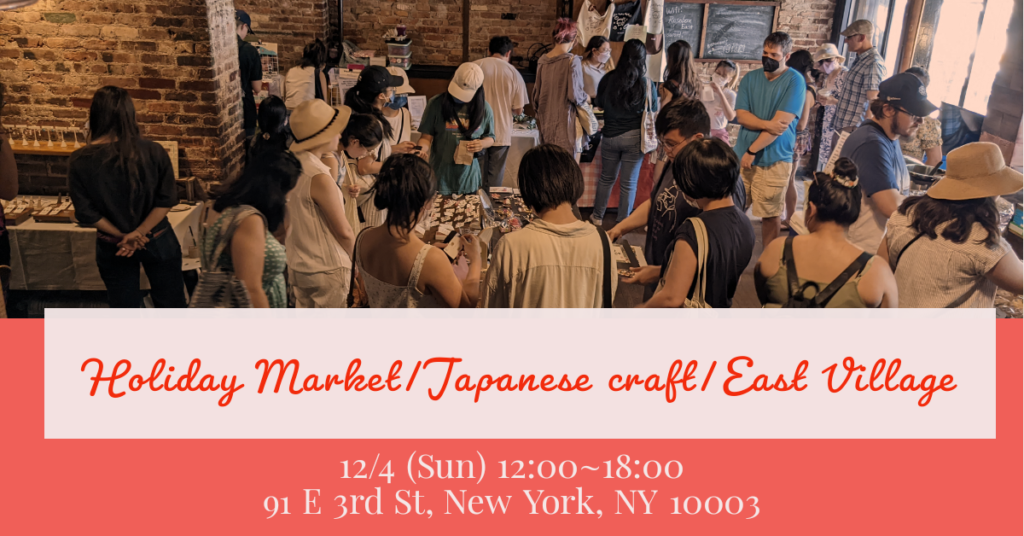
Accessories such as earrings, necklaces, and more Japanese-inspired products will be on sale! Japanese artist and Japanese-inspired artists are all welcome to join and promote their works! Please join us and see each artist’s unique creations! We will have Japanese onigiri vendor this time!We will have Japanese food and snacks at the event!
■Location:91 E 3rd St, New York, NY 10003
■Date: Dec 24th(Sun) 12PM~6PM
Our Vendors
【BOOKAT NYC Jewelry】
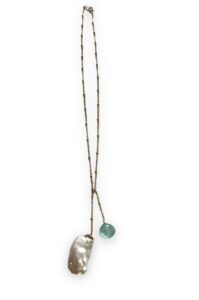
Heart felt, hand made from Brooklyn using 14kt gold-filled metal and semi-precious stones and fresh water pearls. Whimsical, playful yet feminine jewelry. Please make us be with you or special someone in the moments of joy and happiness:):):)
【Boy Oh Boy Co】
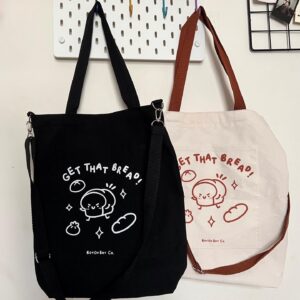
Hi, we are Cindy and Kristy, two best friends and the owners of Boy Oh Boy Co. We are self-taught artists based in Brooklyn. We love making cute affordable stationery items like stickers for planners and bullets journals. We also have enamel pins, letter sets, and more to come!
【Fragrant Olive】
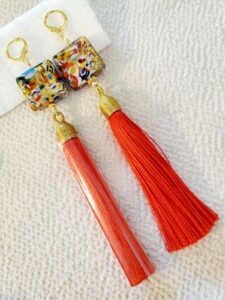
【Meloncholy Co.】
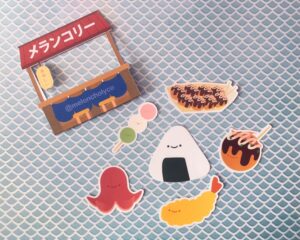
Cute handmade stationery and miscellaneous items such as stickers, postcards, greeting cards, magnets, washi tape, t-shirts, pins, and notepads.
【Lunaris】
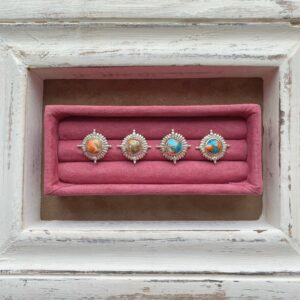
Hand crafted from start to finish.
Lunaris Jewelry by NYC based Japanese designer Airi Nishiguchi captures
the purity and effervescence of the moment you see a rainbow or a full moon.
With dozens of designs available in Sterling Silver, Brass and 14k gold as well as comissioned pieces, you can bring a bit of charm and delight to your look.
【chez téja】
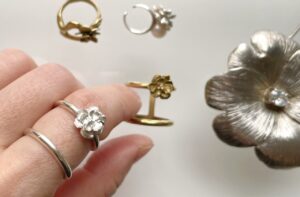
Inspired from strong and beautiful nature. Jewelries by téja remind you that you are strong and beautiful. You all are flawless. Decorate your own style with these jewelries.
【Japanklyn】

Japanklyn was founded in 2020 in Brooklyn, NY.
It all started in a small apartment with our love and compassion for Japan and Brooklyn and a passion for fashion, specifically hat.
The pride, respect, and patriotism for Japan and the culture, along with love for our community, culture, and lifestyle of Brooklyn, all fused like a chemical reaction.
【Riverside Wrapping Co.】
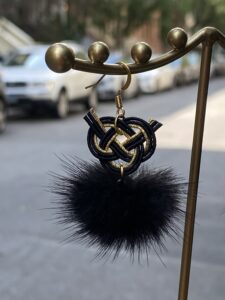
Riverside Wrapping Co. offers high quality custom gift wrapping service and Mizuhiki (Japanese paper cords) accesories by certified Gift Wrapping Coordinator Emi, based in Upper West Side, NY.
【Bead Factory Ever Green】
Japanese Food will be sold at the event !!
Japanese Curry And Rice by “Kare Girls 華麗な女子達”

Oyamada Japan
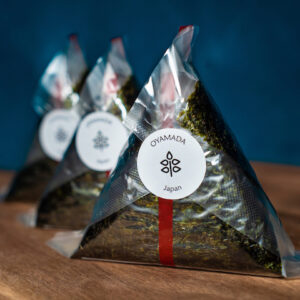
Nanaumi Nanami Artist Presentation
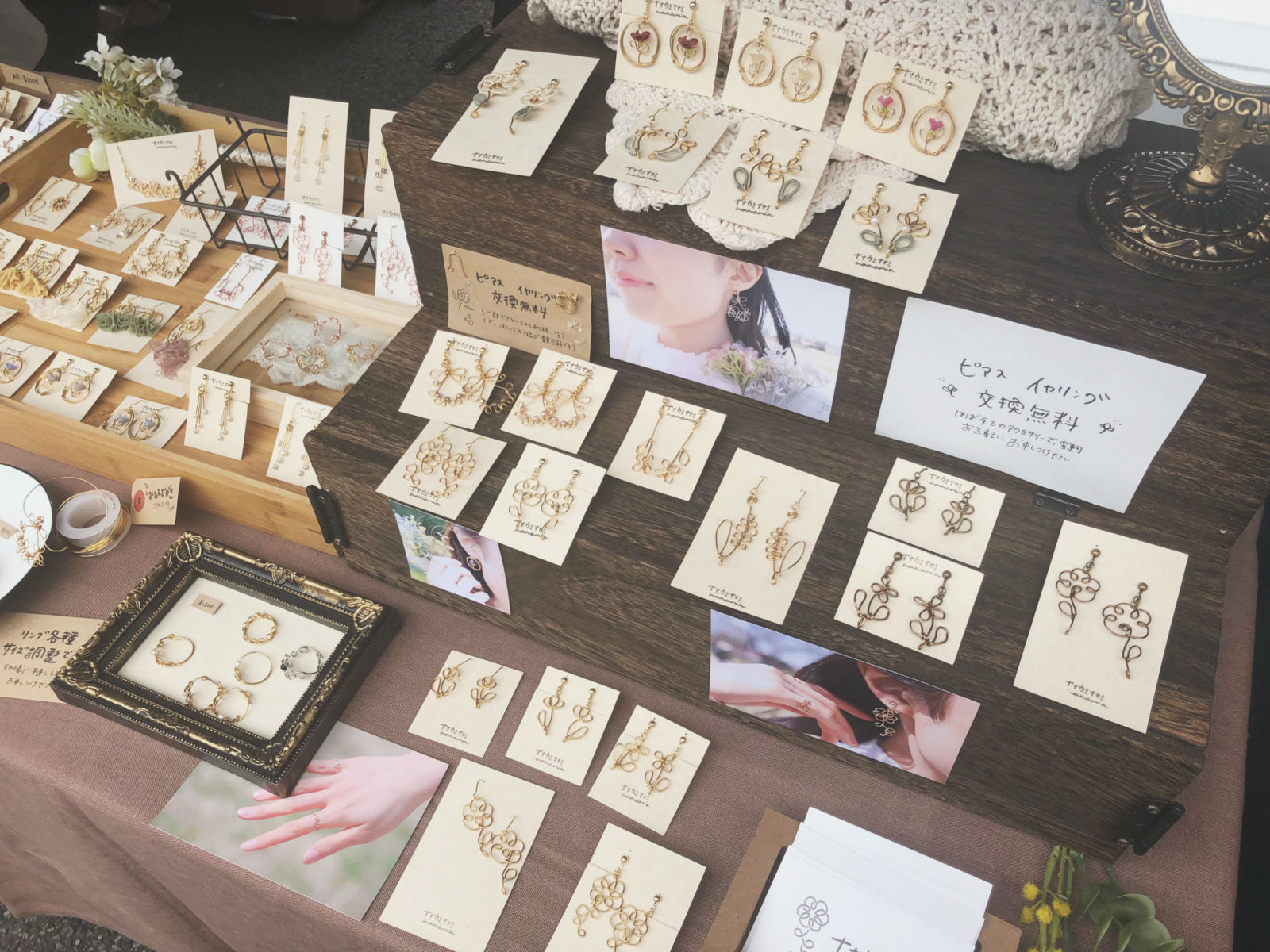
nanaumi nanami creates beautiful, classy plant themed hand made accessories using wire.
“Bringing little happiness to your everyday life” is her motto. She wishes for people to find a happiness by wearing her accessories.

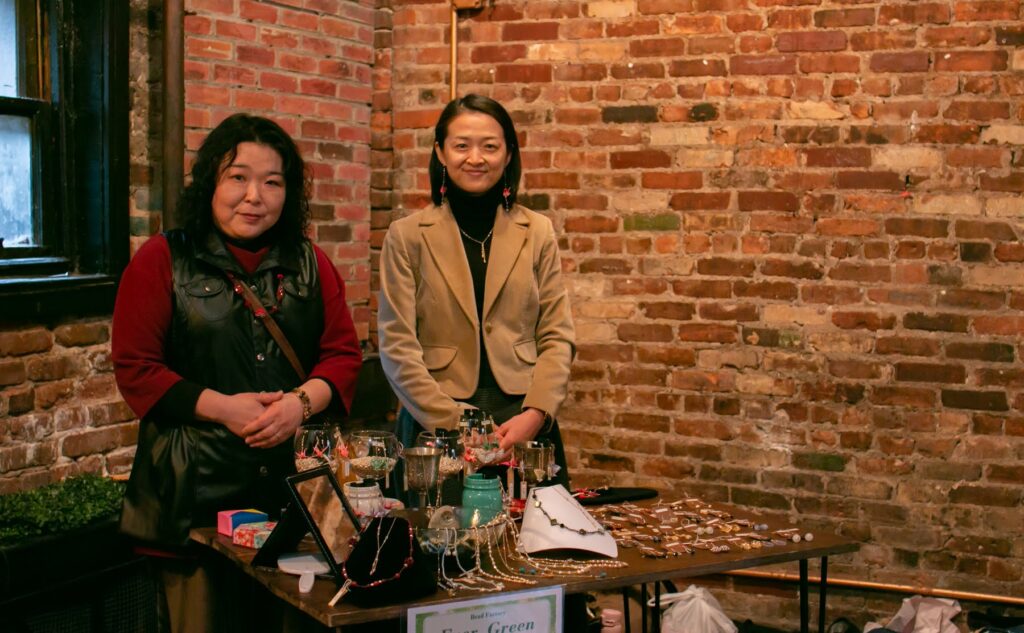
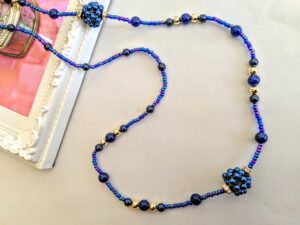
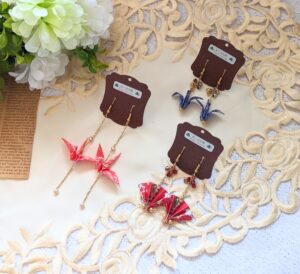
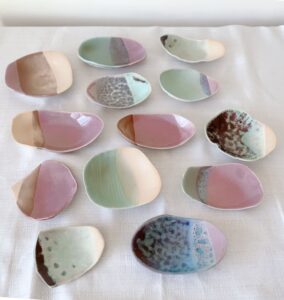
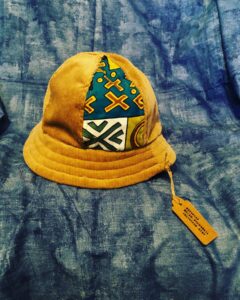
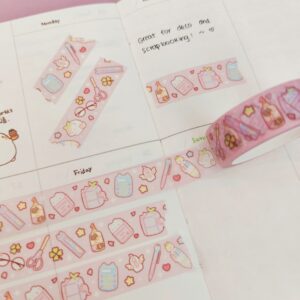
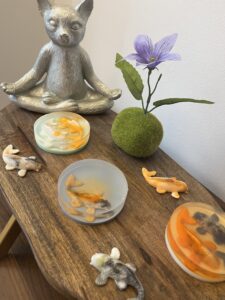
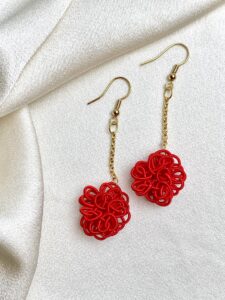
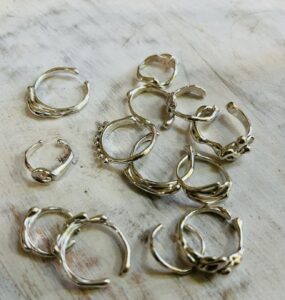
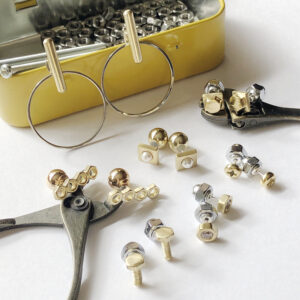

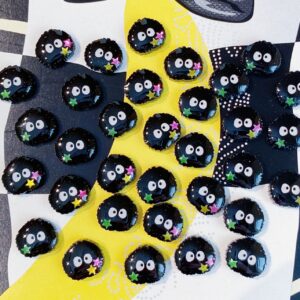
 Resin & air dry clay
Resin & air dry clay
